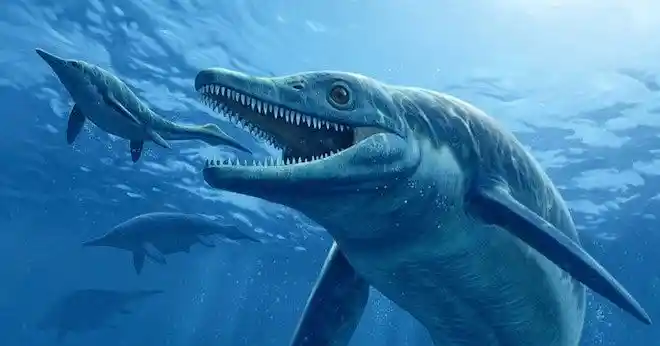When The Monster Returned
We have heard of a variety of sea creatures who have haunted the deep blue waters for centuries. Though the majority of them no longer exist, imagine that ‘What If’ scene when a huge ichthyosaur roamed around the waters to find its prey.

When the predator goes out for a hunt; Image Source: WIRED
Swimming with its humongous tail, ichthyosaurs roamed around in the waters of unknown oceans. While enormous dinosaurs dominated the land during Mesozoic Era, creatures like giant ichthyosaur ruled the sea. Some 180 million years ago, a huge dolphin-like creature sank to the bottom of an ancient sea and dies. Shockingly, the saline seawater had preserved its body in excellent condition including those chemical clues that suggested that the prehistoric animals had whale-like blubber.
However, intense research and proper investigation finally brought out the much-awaited results in the Nature journal. The fossil was found to have preserved the body of a Stenopterygius, a kind of marine reptile called an ichthyosaur that lived during the Jurassic period.
“Not only can you look at these structures and identify them at the cellular level, there's traces of the original protein in there—this is the tip of the iceberg, into Jurassic Park-type stuff,” said Benjamin Kear, a paleontologist at Uppsala University.
Even before dinosaurs landed on earth and were named by science as extinct species, the 19th-century natural philosophers imagined a fish lizard, naming it ichthyosaurs. Known as the dolphin of the Mesozoic era, these creatures had leathery skin, slender jaws, and bodies built for extreme agile movements.
“They came from lung-breathing reptiles on land and pretty quickly became fish-shaped after 30 million years. Ichthyosaurs are the first; whales did it later. They have the largest eyes of all vertebrates, and some later species had the highest number of fingers: nine to 10 in one hand.”, said Ryosuke Motani, a paleontologist at the University of California, Davis, who studies ichthyosaurs.
But this was not all. Though India is far away from these foreign lands, waterways connect it to a variety of countries where ichthyosaurs were originally found. People are bounded by borders, but fishes are not. Long long ago, when an ichthyosaur swam through the waters, it reached India and stayed in the waters till its death.
Finally, a group of German and Indian scientists formed an excavation team and found the remains of a 150-million-year-old ichthyosaur in Kutch in Gujarat. Before this excavation, no Jurassic era fossils have ever been found in India. But the excavation of this 5.5-metre fossil gave an entirely new direction to the evolution of species in the subcontinent.
This was not a planned excavation, but a routine exploration. When the scientists detected something hidden beneath the sand, the entire excavation team arrived and it took more than 1,500 man-hours to completely carve out the skeleton from beneath the sand. Though the entire body was intact, the posterior part of the skull, hind fins, and posterior tail bones was absent.
After a morphological study conducted by the team, it was found that the 152-million year-old skeleton belonged to Ophthalmosauridae, a member of ichthyosaurs that lived in the ocean 165 million years ago and 90 million years ago, a time when dinosaurs ruled the land and pterosaurs ruled the air.
“The new find is very important because it is the first fossil ichthyosaur from the Jurassic rocks of India and is expected to provide insights into the diversity and evolution of marine reptiles in the Indian subcontinent and the former Gondwanaland,” said Professor Guntupalli V R Prasad of Delhi University’s department of geology who led the entire team of scientists.
This was just the beginning of a more intricate world of extinct animals. As technology advances, some scientists claim that they could bring back extinct animals to the world. Though this might sound like a far-fetched concept to most of us, discoveries and constant research might shock us one day as we see a dinosaur walking in the zoo.

When India found a hidden treasure; Image Source: Independent


